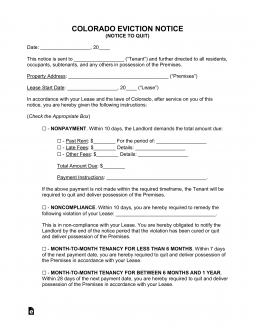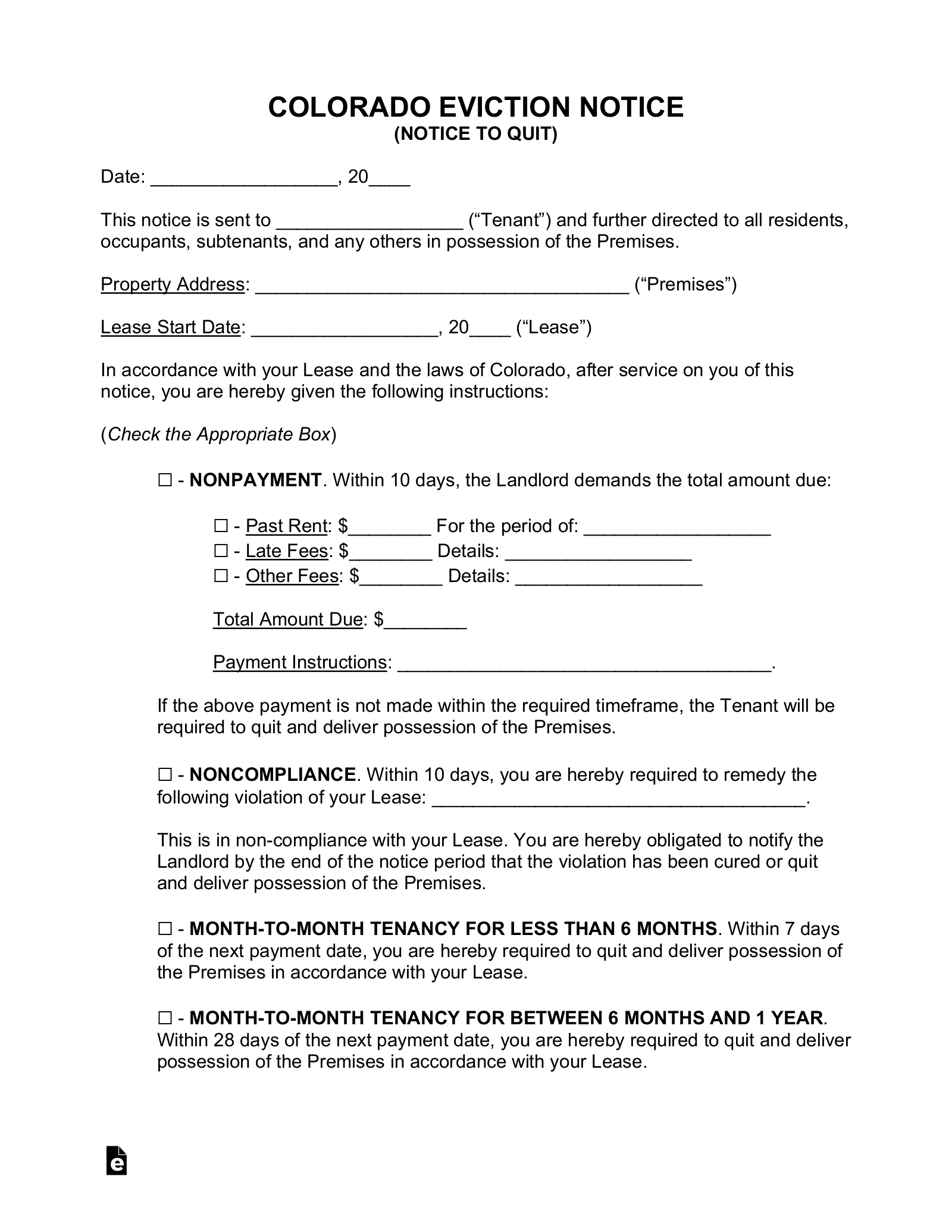Updated February 16, 2024
A Colorado eviction notice is a letter served by a landlord to a tenant notifying that they have committed a lease violation. The notice will include the details of the offense and the number of days the tenant has the right to cure the issue. If the violation remains after the notice period, the tenant will be required to move out or face an eviction lawsuit.
By Type (2)
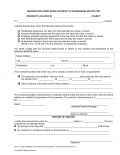 10-Day Notice to Quit (Non-Payment & Non-Compliance) – This form is used to provide notice to a tenant who is in violation of a lease. The tenant will have 10 days to either comply with the terms of the lease as set forth in the notice or leave the premises. 10-Day Notice to Quit (Non-Payment & Non-Compliance) – This form is used to provide notice to a tenant who is in violation of a lease. The tenant will have 10 days to either comply with the terms of the lease as set forth in the notice or leave the premises.
Download: PDF (Form JDF-101) |
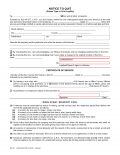 Month-to-Month Lease Termination Letter – This form may be used when a landlord seeks to terminate a lease with the tenant. The landlord must comply with the notice requirement based on the amount of time the tenant has occupied the property. Month-to-Month Lease Termination Letter – This form may be used when a landlord seeks to terminate a lease with the tenant. The landlord must comply with the notice requirement based on the amount of time the tenant has occupied the property.
Download: PDF (JDF-99) |
Table of Contents |
Eviction Laws
- Rent Grace Period: As indicated in the lease agreement.[1]
- Late Fees Grace Period: No late fees permitted by the lease agreement can be charged until the rent is 7 days late.[2]
- Non-Payment of Rent: 10 days.[3]
- Non-Compliance: 10 days.[4]
- Termination (Month-to-Month Lease):[5]
- 1 year or longer: 91 days.
- 6 months to less than 1 year: 28 days.
- 1 month to less than 6 months: 7 days.
- 1 week to less than 1 month: 3 days.
- Less than 1 week: 1 day.
- Eviction Lawsuit: Removal of Unauthorized Persons.[6]
Prohibited Landlord Actions
Utility Shutoff – The landlord is prohibited by law from shutting off utilities in response to a tenant’s nonpayment of rent.[7]
Changing the Locks – The landlord may not remove the locks, doors, or windows of the premises other than as required for maintenance or repair.
Court Forms
Demand for Compliance or Right to Possession Notice (JDF 101) – As opposed to the Notice to Quit (below), this document provides the demand for compliance to the covenant stated in the document or the deliverance of possession to the landlord.
Notice to Quit (JDF-97) – This is the first form delivered to the tenant to let them know that their tenancy will be terminated and that they must vacate the residence on the date specified therein.
Complaint (JDF-99) – Served on the tenant and filed with the court should the individual fail to respond to the Notice to Quit or Form JDF 101 in the given timeframe. This begins the eviction process.
Summons (CRCCP 1A) – Filed with the court in conjunction with the complaint. It can then be served on the tenant notifying them that they are due in court at the date specified therein. It also provides instructions with regard to their response in either denying or complying with the claims made in the Complaint.
Answer Form – To be served on the tenant with the summons and complaint to provide them the opportunity to deny the charges against them.
Affidavit of Service – Used to prove that the necessary documents were served on the defendant. Should be filed with the clerk on or before the court date.
Motion for Judgment – This form indicates to the court what the landlord is demanding in the case, either money, possession, or both.
Order – This document indicates the monetary value awarded to the landlord and the return of possession of the property to the plaintiff.
Writ of Restitution – To be completed should the tenant fail to vacate the premises within 48 hours of the judgment being passed against them.
How to Evict a Tenant (5 steps)
- Provide Notice to the Tenant
- File the Complaint and Summons
- Serve Forms on the Tenant
- Tenant’s Response
- Court Date and Judgment
1. Provide Notice to the Tenant

The eviction process involves first notifying the tenant. If the tenant is in violation of the lease, the landlord may provide a 10-Day Notice to Quit (Non-Payment & Non-Compliance). If the landlord seeks to terminate the lease, the landlord may provide a Month-to-Month Termination Letter.
2. File the Complaint and Summons

If the tenant fails to comply with the notice, the landlord may file an action with the county court by filing the following documents:
The filing fee ranges from $85 to $135, depending on the claim amount.[8]
3. Serve Forms on the Tenant
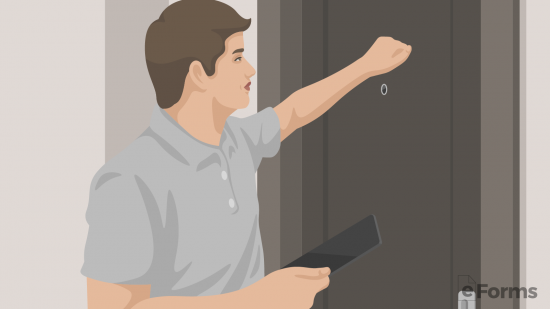
Once a court date has been set, you must serve the filed forms to the tenant, also known as the defendant, using a civil process server. The service must be completed at least seven days before the court date. The process server will provide an affidavit of service for the landlord to file with the court.
4. Tenant’s Response

The defendant may use the Answer to respond to the Complaint. The court will decide at the hearing who is entitled to possession and if there are any damages. If the defendant does not respond, the landlord may file the following documents in order to obtain a judgment:
5. Court Date and Judgment
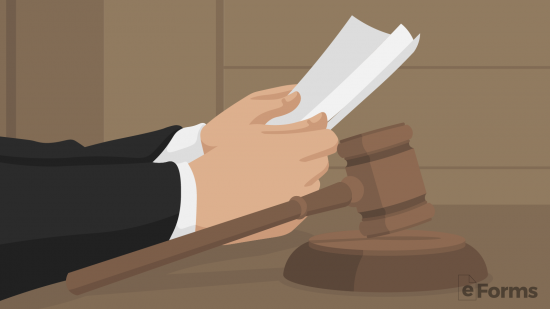
Both parties will be required to attend the eviction hearing and make their cases to the judge. After each party is heard, the judge will give their judgment.
If the tenant is ordered to be evicted, and if the tenant has not responded within 48 hours after judgment, the landlord may file a Writ of Restitution to force the tenant to vacate.

